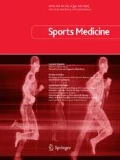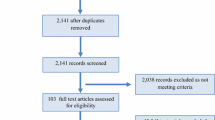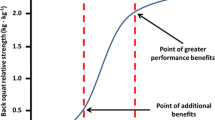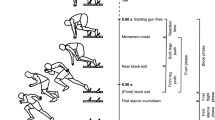Abstract
Background
Sprinting is key in the development and final results of competitions in a range of sport disciplines, both individual (e.g., athletics) and team sports. Resisted sled training (RST) might provide an effective training method to improve sprinting, in both the acceleration and the maximum-velocity phases. However, substantial discrepancies exist in the literature regarding the influence of training status and sled load prescription in relation to the specific components of sprint performance to be developed and the phase of sprint.
Objectives
Our objectives were to review the state of the current literature on intervention studies that have analyzed the effects of RST on sprint performance in both the acceleration and the maximum-velocity phases in healthy athletes and to establish which RST load characteristics produce the largest improvements in sprint performance.
Methods
We performed a literature search in PubMed, SPORTDiscus, and Web of Science up to and including 9 January 2018. Peer-reviewed studies were included if they met all the following eligibility criteria: (1) published in a scientific journal; (2) original experimental and longitudinal study; (3) participants were at least recreationally active and towed or pulled the sled while running at maximum intensity; (4) RST was one of the main training methods used; (5) studies identified the load of the sled, distance covered, and sprint time and/or sprint velocity for both baseline and post-training results; (6) sprint performance was measured using timing gates, radar gun, or stopwatch; (7) published in the English language; and (8) had a quality assessment score > 6 points.
Results
A total of 2376 articles were found. After filtering procedures, only 13 studies were included in this meta-analysis. In the included studies, 32 RST groups and 15 control groups were analyzed for sprint time in the different phases and full sprint. Significant improvements were found between baseline and post-training in sprint performance in the acceleration phase (effect size [ES] 0.61; p = 0.0001; standardized mean difference [SMD] 0.57; 95% confidence interval [CI] − 0.85 to − 0.28) and full sprint (ES 0.36; p = 0.009; SMD 0.38; 95% CI − 0.67 to − 0.10). However, non-significant improvements were observed between pre- and post-test in sprint time in the maximum-velocity phase (ES 0.27; p = 0.25; SMD 0.18; 95% CI − 0.49 to 0.13). Furthermore, studies that included a control group found a non-significant improvement in participants in the RST group compared with the control group, independent of the analyzed phase.
Conclusions
RST is an effective method to improve sprint performance, specifically in the early acceleration phase. However, it cannot be said that this method is more effective than the same training without overload. The effect of RST is greatest in recreationally active or trained men who practice team sports such as football or rugby. Moreover, the intensity (load) is not a determinant of sprint performance improvement, but the recommended volume is > 160 m per session, and approximately 2680 m per total training program, with a training frequency of two to three times per week, for at least 6 weeks. Finally, rigid surfaces appear to enhance the effect of RST on sprint performance.










Similar content being viewed by others
Change history
09 July 2018
Page 1: Abstract, Conclusions, sentence 4. The following sentence, which read:
References
Faude O, Koch T, Meyer T. Straight sprinting is the most frequent action in goal situations in professional football. J Sports Sci. 2012;30(7):625–31.
Haugen TA, Tønnessen E, Seiler S. Speed and countermovement-jump characteristics of elite female soccer players, 1995–2010. Int J Sports Physiol Perform. 2012;7(4):340–9.
Haugen TA, Tønnessen E, Seiler S. Anaerobic performance testing of professional soccer players 1995–2010. Int J Sports Physiol Perform. 2013;8(2):148–56.
Vescovi JD. Impact of maximum speed on sprint performance during high-level youth female field hockey matches: Female Athletes in Motion (FAiM) study. Int J Sports Physiol Perform. 2014;9(4):621–6.
Mann RA, Hagy J. Biomechanics of walking, running, and sprinting. Am J Sports Med. 1980;8(5):345–50.
Young W, Benton D, Duthie G, Pryor J. Resistance training for short sprints and maximum-speed sprints. Strength Cond J. 2001;23(2):7–13.
Mero A, Komi P, Gregor R. Biomechanics of sprint running. A review. Sports Med. 1992;13(6):376–92.
Alexander RM. Mechanics of skeleton and tendons. Handbook of physiology—the nervous system. Am Physiol Soc. 1981;2:17–42.
Rabita G, Dorel S, Slawinski J, Saez-de-Villarreal E, Couturier A, Samozino P, et al. Sprint mechanics in world-class athletes: a new insight into the limits of human locomotion. Scand J Med Sci Sports. 2015;25(5):583–94.
Mero A, Komi PV. Force-, EMG-, and elasticity-velocity relationships at submaximal, maximal and supramaximal running speeds in sprinters. Eur J Appl Physiol Occup Physiol. 1986;55(5):553–61.
Delecluse C. Influence of strength training on sprint running performance. Sports Med. 1997;24(3):147–56.
Weyand PG, Sandell RF, Prime DNL, Bundle MW. The biological limits to running speed are imposed from the ground up. J Appl Physiol. 2010;108(4):950–61.
Weyand PG, Sternlight DB, Bellizzi MJ, Wright S. Faster top running speeds are achieved with greater ground forces not more rapid leg movements. J Appl Physiol. 2000;89(5):1991–9.
Clark KP, Weyand PG. Are running speeds maximized with simple-spring stance mechanics? J Appl Physiol. 2014;117(6):604–15.
DeWeese BH, Bellon C, Magrum E, Taber CB, Suchomel TJ. Strengthening the springs: improving sprint performance via strength training. Track Tech. 2016;9(3):8–20.
Nagahara R, Mizutani M, Matsuo A, Kanehisa H, Fukunaga T. Step-to-step spatiotemporal variables and ground reaction forces of intra-individual fastest sprinting in a single session. J Sports Sci. 2017;36(12):1392–401.
Nagahara R, Mizutani M, Matsuo A, Kanehisa H, Fukunaga T. Association of sprint performance with ground reaction forces during acceleration and maximal speed phases in a single sprint. J Appl Biomech. 2017;34:104–10.
Dalleau G, Belli A, Bourdin M, Lacour J-R. The spring-mass model and the energy cost of treadmill running. Eur J Appl Physiol Occup Physiol. 1998;77(3):257–63.
Voigt M, Bojsen-Møller F, Simonsen EB, Dyhre-Poulsen P. The influence of tendon Youngs modulus, dimensions and instantaneous moment arms on the efficiency of human movement. J Biomech. 1995;28(3):281–91.
Plisk SS. Speed, agility, and speed-endurance development. In: Baechle TR, Earle RW, editors. National strength and conditioning association: essentials of strength training & conditioning. 2nd ed. Champaign IL: Human Kinetics; 2000. p. 471–91.
MacDougall D, Sale D. Continuous vs. interval training: a review for the athlete and the coach. Can J Appl Sport Sci. 1981;6(2):93–7.
Iacono AD, Martone D, Milic M, Padulo J. Vertical-vs. horizontal-oriented drop jump training: Chronic effects on explosive performances of elite handball players. J Strength Cond Res. 2017;31(4):921–31.
Rumpf MC, Lockie RG, Cronin JB, Jalilvand F. Effect of different sprint training methods on sprint performance over various distances: a brief review. J Strength Cond Res. 2016;30(6):1767–85.
Freitas TT, Martinez-Rodriguez A, Calleja-González J, Alcaraz PE. Short-term adaptations following complex training in team-sports: a meta-analysis. PLoS One. 2017;12(6):e0180223.
Seitz LB, Reyes A, Tran TT, de Villarreal ES, Haff GG. Increases in lower-body strength transfer positively to sprint performance: a systematic review with meta-analysis. Sports Med. 2014;44(12):1693–702.
Hill A. The heat of shortening and the dynamic constants of muscle. Proc R Soc Lond B Biol Sci. 1938;126(843):136–95.
Hill A, Long C, Lupton H. The effect of fatigue on the relation between work and speed, in contraction of human arm muscles. J Physiol. 1924;58(4–5):334–7.
Cormie P, McGuigan MR, Newton RU. Developing maximal neuromuscular power part 2-training considerations for improving maximal power production. Sports Med. 2011;41(2):125–46.
Randell AD, Cronin JB, Keogh JWL, Gill ND. Transference of strength and power adaptation to sports performance-horizontal and vertical force production. Strength Cond J. 2010;32(4):100–6.
Haff GG, Nimphius S. Training principles for power. Strength Cond J. 2012;34(6):2–12.
Alcaraz PE, Palao JM, Elvira JLL, Linthorne NP. Effects of three types of resisted sprint training devices on the kinematics of sprinting at maximum velocity. J Strength Cond Res. 2008;22(3):890–7.
Kawamori N, Newton R, Nosaka K. Effects of weighted sled towing on ground reaction force during the acceleration phase of sprint running. J Sports Sci. 2014;32(12):1139–45.
Brown SC, Craik FI. Encoding and retrieval of information. In: Tulving E, Craik FIM, editors. The Oxford handbook of memory. 2000. p. 93–107.
Haff GG, Stone MH. Methods of developing power with special reference to football players. Strength Cond J. 2015;37(6):2–16.
Alcaraz PE, Palao JM, Elvira JL. Determining the optimal load for resisted sprint training with sled towing. J Strength Cond Res. 2009;23(2):480–5.
Jakalski K. The pros and cons of using resisted and assisted training methods with high school sprinters: parachutes, tubing and towing. Track Coach. 1998;144:4585–9.
Lockie RG, Murphy AJ, Spinks CD. Effects of resisted sled towing on sprint kinematics in field-sport athletes. J Strength Cond Res. 2003;17(4):760–7.
Cottle CA, Carlson LA, Lawrence MA. Effects of sled towing on sprint starts. J Strength Cond Res. 2014;28(5):1241–5.
Kawamori N, Newton RU, Hori N, Nosaka K. Effects of weighted sled towing with heavy versus light load on sprint acceleration ability. J Strength Cond Res. 2014;28(10):2738–45.
Monte A, Nardello F, Zamparo P. Sled towing: the optimal overload for peak power production. Int J Sports Physiol Perform. 2016;12(8):1052–8.
Cross MR, Brughelli M, Samozino P, Brown SR, Morin J-B. Optimal loading for maximising power during sled-resisted sprinting. Int J Sports Physiol Perform. 2017;12(8):1069–77.
Samozino P, Rabita G, Dorel S, Slawinski J, Peyrot N, Saez de Villarreal E, et al. A simple method for measuring power, force, velocity properties, and mechanical effectiveness in sprint running. Scand J Med Sci Sports. 2016;26(6):648–58.
Cronin JB, Hansen K, Kawamori N, McNair P. Effects of weighted vests and sled towing on sprint kinematics. Sports Biomech. 2008;7(2):160–72.
Maulder PS, Bradshaw EJ, Keogh JWL. Kinematic alterations due to different loading schemes in early acceleration sprint performance from starting blocks. J Strength Cond Res. 2008;22(6):1992–2002.
Martinez-Valencia MA, Romero-Arenas S, Elvira JLL, Gonzalez-Rave JM, Navarro-Valdivielso F, Alcaraz PE. Effects of sled towing on peak force, the rate of force development and sprint performance during the acceleration phase. J Hum Kinet. 2015;46(1):139–48.
Linthorne NP, Cooper JE. Effect of the coefficient of friction of a running surface on sprint time in a sled-towing exercise. Sports Biomech. 2013;12(2):175–85.
Petrakos G, Morin JB, Egan B. Resisted sled sprint training to improve sprint performance: A systematic review. Sports Med. 2016;46(3):381–400.
Moher D, Liberati A, Tetzlaff J, Altman DG, Prisma G. Preferred reporting items for systematic reviews and meta-analyses: the PRISMA statement. PLoS Med. 2009;6(7):e1000097.
Bhogal SK, Teasell RW, Foley NC, Speechley MR. The PEDro scale provides a more comprehensive measure of methodological quality than the Jadad scale in stroke rehabilitation literature. J Clin Epidemiol. 2005;58(7):668–73.
de Morton NA. The PEDro scale is a valid measure of the methodological quality of clinical trials: a demographic study. Aust J Physiother. 2009;55(2):129–33.
Maher CG, Sherrington C, Herbert RD, Moseley AM, Elkins M. Reliability of the PEDro scale for rating quality of randomized controlled trials. Phys Ther. 2003;83(8):713–21.
Cohen J. Statistical power analysis for the behavioral sciences (revised ed.). New York: Academic; 1977.
Hopkins W, Marshall S, Batterham A, Hanin J. Progressive statistics for studies in sports medicine and exercise science. Med Sci Sports Exerc. 2009;41(1):3.
Higgins JP, Green S. Cochrane handbook for systematic reviews of interventions. New York: Wiley; 2011.
Zafeiridis A, Saraslanidis P, Manou V, Ioakimidis P, Dipla K, Kellis S. The effects of resisted sled-pulling sprint training on acceleration and maximum speed performance. J Sports Med Phys Fit. 2005;45(3):284–90.
Spinks CD, Murphy AJ, Spinks WL, Lockie RG. The effects of resisted sprint training on acceleration performance and kinematics in soccer, rugby union, and Australian football players. J Strength Cond Res. 2007;21(1):77–85.
Harrison AJ, Bourke G. The effect of resisted sprint training on speed and strength performance in male rugby players. J Strength Cond Res. 2009;23(1):275–83.
Clark KP, Stearne DJ, Walts CT, Miller AD. The longitudinal effects of resisted sprint training using weighted sleds vs weighted vests. J Strength Cond Res. 2010;24(12):3287–95.
Lockie RG, Murphy AJ, Schultz AB, Knight TJ, de Jonge XAKJ. The effects of different speed training protocols on sprint acceleration kinematics and muscle strength and power in field sport athletes. J Strength Cond Res. 2012;26(6):1539–50.
Makaruk B, Sozański H, Makaruk H, Sacewicz T. The effects of resisted sprint training on speed performance in women. Hum Mov Sci. 2013;14(2):116–22.
West DJ, Cunningham DJ, Bracken RM, Bevan HR, Crewther BT, Cook CJ, et al. Effects of resisted training on acceleration in professional rugby union players. J Strength Cond Res. 2013;27(4):1014–8.
Alcaraz PE, Elvira JLL, Palao JM. Kinematic, strength, and stiffness adaptations after a short-term sled towing training in athletes. Scand J Med Sci Sports. 2014;24(2):279–90.
Bachero-Mena B, Gonzalez-Badillo JJ. Effects of resisted sprint training on acceleration with three different loads accounting for 5, 12.5, and 20% of body mass. J Strength Cond Res. 2014;28(10):2954–60.
Luteberget LS, Raastad T, Seynnes O, Spencer M. Effect of traditional and resisted sprint training in highly trained female team handball players. Int J Sports Physiol Perform. 2015;10(5):642–7.
de Hoyo M, Gonzalo-Skok O, Sañudo B, Carrascal C, Plaza-Armas JR, Camacho-Candil F, et al. Comparative effects of in-season full-back squat, resisted sprint training, and plyometric training on explosive performance in U-19 elite soccer players. J Strength Cond Res. 2016;30(2):368–77.
Morin JB, Petrakos G, Jimenez-Reyes P, Brown SR, Samozino P, Cross MR. Very-heavy sled training for improving horizontal force output in soccer players. Int J Sports Physiol Perform. 2016;12(6):840–4.
Ross A, Leveritt M, Riek S. Neural influences on sprint running. Sports Med. 2001;31(6):409–25.
Van Hooren B, Bosch F. Is there really an eccentric action of the hamstrings during the swing phase of high-speed running? part I: a critical review of the literature. J Sports Sci. 2017;35(23):2313–21.
Van Hooren B, Bosch F. Is there really an eccentric action of the hamstrings during the swing phase of high-speed running? Part II: implications for exercise. J Sports Sci. 2017;35(23):2322–33.
Reeves ND, Narici MV. Behavior of human muscle fascicles during shortening and lengthening contractions in vivo. J Appl Physiol. 2003;95(3):1090–6.
Ettema G. Mechanical efficiency and efficiency of storage and release of series elastic energy in skeletal muscle during stretch-shorten cycles. J Exp Biol. 1996;199(9):1983–97.
Nagano A, Komura T, Fukashiro S. Effects of the length ratio between the contractile element and the series elastic element on an explosive muscular performance. J Electromyogr Kinesiol. 2004;14(2):197–203.
Comfort P, Bullock N, Pearson SJ. A comparison of maximal squat strength and 5-, 10-, and 20-meter sprint times, in athletes and recreationally trained men. J Strength Cond Res. 2012;26(4):937–40.
McLean B. Biomechanics of running. In: Hawley JA, editor. Handbook of sports medicine and science: running. John Wiley & Sons; 2008. p. 28–43.
Schmidtbleicher D. Strength training: part 2: structural analysis of motor strength qualities and its application to training. Sci Period Res Tech Sport. 1985;4:1–10.
Schmidtbleicher D. Strength training: part 1: structural analysis of motor strength qualities and its application to training. Sci Period Res Tech Sport. 1985;4:1–12.
Siff M, Verkhoshansky Y. Supertraining. Denver: Supertraining Institute; 2003.
Farley CT, Gonzalez O. Leg stiffness and stride frequency in human running. J Biomech. 1996;29(2):181–6.
Brughelli M, Cronin J. A review of research on the mechanical stiffness in running and jumping: methodology and implications. Scand J Med Sci Sports. 2008;18(4):417–26.
Kraemer WJ, Adams K, Cafarelli E, Dudley GA, Dooly C, Feigenbaum MS, American College of Sports Medicine position stand, et al. Progression models in resistance training for healthy adults. Med Sci Sports Exerc. 2002;34(2):364–80.
Barnes C, Archer D, Hogg B, Bush M, Bradley P. The evolution of physical and technical performance parameters in the English Premier League. Int J Sports Med. 2014;35(13):1095–100.
Bolger R, Lyons M, Harrison AJ, Kenny IC. Sprinting performance and resistance-based training interventions: a systematic review. J Strength Cond Res. 2015;29(4):1146–56.
Author information
Authors and Affiliations
Corresponding authors
Ethics declarations
Funding
No sources of funding were used to assist in the preparation of this article.
Conflict of interest
Pedro E. Alcaraz, Jorge Carlos-Vivas, Bruno O. Oponjuru, and Alejandro Martínez-Rodríguez have no conflicts of interest relevant to the content of this review.
Additional information
The original version of this article was revised: Due to errors in the text.
Rights and permissions
About this article
Cite this article
Alcaraz, P.E., Carlos-Vivas, J., Oponjuru, B.O. et al. The Effectiveness of Resisted Sled Training (RST) for Sprint Performance: A Systematic Review and Meta-analysis. Sports Med 48, 2143–2165 (2018). https://doi.org/10.1007/s40279-018-0947-8
Published:
Issue Date:
DOI: https://doi.org/10.1007/s40279-018-0947-8




